

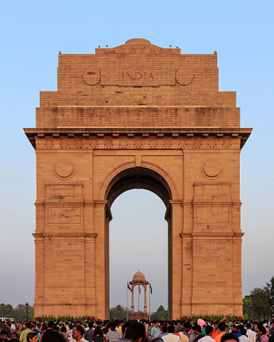
The India Gate (formerly known as the All India War Memorial) is a war memorial located astride the Rajpath, on the eastern edge of the "ceremonial axis" of New Delhi, formerly called Kingsway. It stands as a memorial to 84,000 soldiers of the British Indian Army who died in between 1914 and 1921 in the First World War and the Third Anglo-Afghan War. 13,300 servicemen's names, including some soldiers and officers from the United Kingdom, are inscribed on the gate. Designed by Sir Edwin Lutyens, the gate evokes the architectural style of the memorial arch such as the Arch of Constantine, in Rome, and is often compared to the Arc de Triomphe in Paris, and the Gateway of India in Mumbai.
The Red Fort or Lal Qila is a historic fort in Old Delhi, that served as the main residence of the Mughal Emperors. Emperor Shah Jahan commissioned construction of the Red Fort on 12 May 1638, when he decided to shift his capital from Agra to Delhi. Originally red and white, its design is credited to architect Ustad Ahmad Lahori, who also constructed the Taj Mahal. The fort represents the peak in Mughal architecture under Shah Jahan, and combines Persianate palace architecture with Indian traditions.
The fort was plundered of its artwork and jewels during Nadir Shah's invasion of the Mughal Empire in 1739.
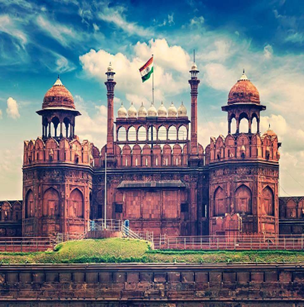
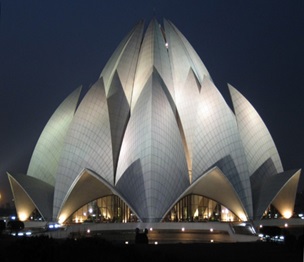
The Lotus Temple, located in Delhi, is a Bahaʼi House of Worship that was dedicated in December 1986. Notable for its flowerlike shape, it has become a prominent attraction in the city. Like all other Baha’i Houses of Worship, the Lotus Temple is open to all, regardless of religion or any other qualification. The building is composed of 27 free-standing marble-clad "petals" arranged in clusters of three to form nine sides, with nine doors opening onto a central hall with a height of slightly over 34 meters and a capacity of 1,300 people. The Lotus Temple has won numerous architectural awards and has been featured in many newspaper and magazine articles.
The Qutb Minar is a minaret and "victory tower" that forms part of the Qutb complex, which lies at the site of Delhi’s oldest fortified city, Lal Kot. It is a UNESCO World Heritage Site in the Mehrauli area of South Delhi. It is one of the most visited tourist spots in the city, mostly built between 1199 and 1220.
It can be compared to the 62-metre all-brick Minaret of Jam in Afghanistan, of c. 1190, which was constructed a decade or so before the probable start of the Delhi tower. The surfaces of both are elaborately decorated with inscriptions and geometric patterns. The Qutb Minar has a shaft that is fluted with "superb stalactite bracketing under the balconies" at the top of each stage. In general, minarets were slow to be used in India and are often detached from the main mosque where they exist.
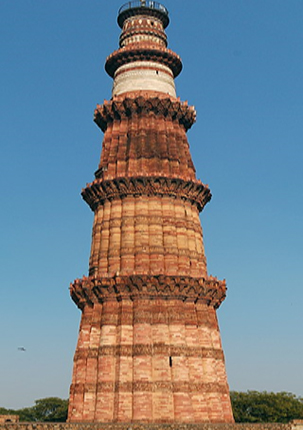
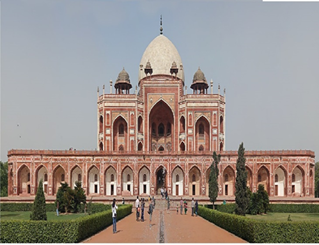
The Qutb Minar is a minaret and "victory tower" that forms part of the Qutb complex, which lies at the site of Delhi’s oldest fortified city, Lal Kot. It is a UNESCO World Heritage Site in the Mehrauli area of South Delhi. It is one of the most visited tourist spots in the city, mostly built between 1199 and 1220.
It can be compared to the 62-metre all-brick Minaret of Jam in Afghanistan, of c. 1190, which was constructed a decade or so before the probable start of the Delhi tower. The surfaces of both are elaborately decorated with inscriptions and geometric patterns. The Qutb Minar has a shaft that is fluted with "superb stalactite bracketing under the balconies" at the top of each stage. In general, minarets were slow to be used in India and are often detached from the main mosque where they exist.
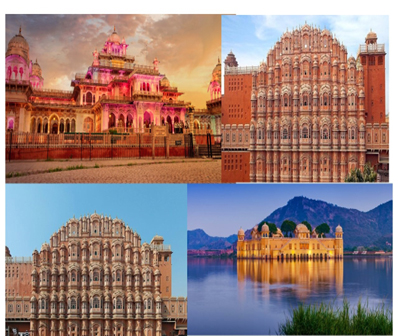
Jaipur, known as the “Pink City”, is the capital of the colourful state of Rajasthan. It has the distinction of being a well planned and laid out city. As you drive through the old part of town, you will witness a life most unlike others. Witness how the city blooms during the da in a kaleidoscope of colour and sound. The capital of Rajasthan, Jaipur is not only the gateway to the state; it was laid out by Maharaja Sawai Jai Singh II of the Kachchawaha dynasty from Amber. In Jaipur, visit the magnificent Amber Fort, City Palace, Museum, The Observatory etc. Enjoy the elephant ride at Amber Fort.
Mehrangarh Fort is located in the city of Jodhpur in the Rajasthan state of India. This fort is known as also jodhpur fort. This giant fort of the fifteenth century is situated on the rocky hill, 125 meters high from the ground, surrounded by a ten-kilometer long high wall with eight doors and countless towers. There are four gates connected to the invisible, winding roads from the outside. Inside the fort, there are many grand palaces, wonderful carvings, latticed windows, and inspiring places.
Notable among these are the Moti Mahal, flower palace, shish mahal, sileh khan, Daulat Khan, etc. These palaces contain an astonishing collection of furnishings of Indian cuisine. Apart from this, there is also a wonderful collection of patrons, elephants, small paintings of different styles, musical instruments, costumes, and furniture.

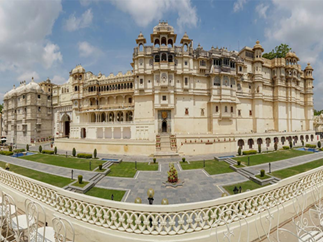
The City Palace Museum, Udaipur is housed within the very iconic, 450 year old Palace, the former abode of the rulers of Mewar. It was formally declared as a Museum open to the public in 1969 through the efforts of Maharana Bhagwat Singh of Mewar (r. 1955-1984 CE). The Mardana Mahal and Zenana Mahal of The City Palace, Udaipur was bequeathed to the Maharana of Mewar Charitable Foundation (MMCF), a trust established by Maharana Bhagwat Singh himself. With it, he also provided a major endowment for the cause. Thus, The City Palace Museum, Udaipur came into being. Fifty years hence; The City Palace Museum has grown immensely and continues to draw visitors in increasing numbers from all across the globe.
Built in 1156 by King Rawal Jaisal, Jaisalmer Fort dominates the countryside in the far northwestern corner of Rajasthan, near the border of India and Pakistan. The magnificent complex, also known as Sonar Kila ("Golden Fort") for its gleaming golden sandstone walls and buildings, flourished on the east-west caravan route connecting India and Central Asia to the Middle East and North Africa. Merchants built elaborately designed havelis among the numerous palaces, temples, bazaars, and residences inside the walls of the complex. The superb architecture within the fort was protected by double fortification walls and circular bastions, key physical components used for defense and battle. Additional features of the fort include a pitching wall to hold the clay soil of the hill in place, a toe wall, and the mori, a pathway between the inner and outer fortification walls that allowed soldiers and horses to move throughout the structure in times of war.
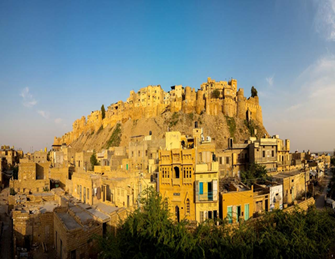
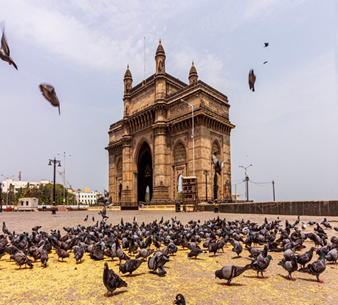
The Gateway of India is an arch monument built during the 20th century in Bombay, India. The monument was erected to commemorate the landing of King George V and Queen Mary at Apollo Bunder on their visit to India in 1911.
Built in Indo-Saracenic style, the foundation stone for the Gateway of India was laid on 31 March 1911. The structure is an arch made of basalt, 26 metres (85 feet) high. The final design of George Wittet was sanctioned in 1914 and the construction of the monument was completed in 1924. The Gateway was later used as a symbolic ceremonial entrance to India for Viceroys and the new Governors of Bombay. It served to allow entry and access to India.
The Gateway of India is located on the waterfront at Apollo Bunder area at the end of Chhatrapati Shivaji Marg in South Mumbai and overlooks the Arabian Sea. The monument has also been referred to as the Taj Mahal of Mumbai, and is the city’s top tourist attraction.
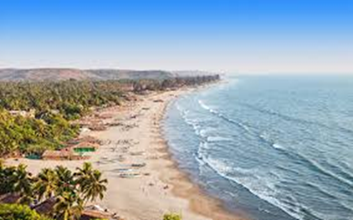
Baga Beach, nestled along the sun-kissed coastline of North Goa, is a vibrant and captivating destination that beckons travellers from around the world. With its unique blend of natural beauty, historical significance, and lively atmosphere, Baga has become a must-visit spot for beach enthusiasts and adventure seekers alike.
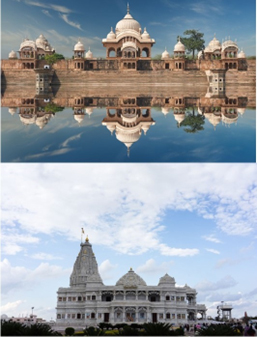
Vrindavan is a holy town in Uttar Pradesh. The Hindu deity Krishna is said to have spent his childhood here. It’s home to temples, many dedicated to Krishna and his lover, the deity Radha. At Banke Bihari Temple, the curtain in front of Krishna’s statue is opened and closed every few minutes. At Radha Raman Temple, a gold plate beside Krishna signifies Radha.
Mathura is a sacred city in Uttar Pradesh. The deity Lord Krishna is said to have been born on the site of Sri Krishna Janma Bhoomi, a Hindu temple. Dotting the Yamuna River are 25 ghats, of which Vishram Ghat is considered the holiest. Sati Burj is a 16th-century memorial tower.
The Taj Mahal is an Islamic ivory-white marble mausoleum on the right bank of the river Yamuna in the city of Agra. It was commissioned in 1632 by the Mughal emperor Shah Jahan to house the tomb of his favourite wife, Mumtaz Mahal; it also houses the tomb of Shah Jahan himself. The tomb is the centrepiece of a 17-hectare (42-acre) complex and is set in formal gardens bounded on three sides by a crenellated wall.
Taj Mahal was designated as a UNESCO World Heritage Site in 1983 for being one of the universally admired masterpieces of the world's heritage". It is regarded by many as the best example of Mughal architecture and a symbol of India's rich history. it was declared a winner of the New 7 Wonders of the World (2000–2007) initiative.
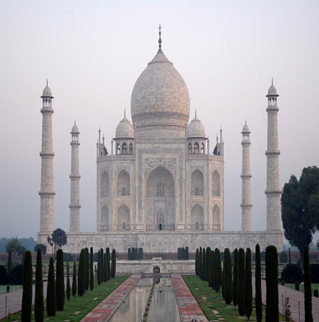
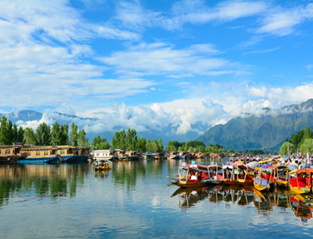
Dal Lake, often referred to as the jewel of Srinagar, is a sprawling urban lake located in the heart of Kashmir, India. This iconic water body spans over 18 square kms and is integral to the tourism and economy of the region. The lake's intricate network of waterways, floating gardens, and houseboats are framed by the majestic Himalayas, providing a picturesque setting.
Affectionately referred to as the "Lake of Flowers”, the lake is crucial for local commerce, supporting industries such as fishing and the harvesting of aquatic plants.
The lake's shoreline is adorned with a boulevard lined with parks, Mughal-era gardens, houseboats, and hotels. Visitors can enjoy stunning views of Dal Lake from the historic Mughal gardens like Shalimar Bagh and Nishat Bagh.

Rishikesh is a city in Dehradun district of the state Uttarakhand. Located in the foothills of the Himalayas in northern India, it is known as the "Gateway to the Garhwal Himalayas" and "Yoga Capital of the World". It lies 21 km north of the city Haridwar and 45 km southeast of the state capital Dehradun. As of 2021, Rishikesh It is known as the pilgrimage town and regarded as one of the holiest places for Hindus. Hindu sages and saints have visited Rishikesh since ancient times to meditate in search of higher knowledge.
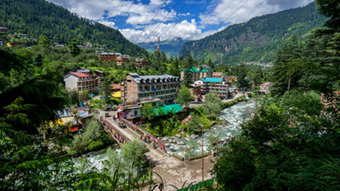
Situated near the end of valley, Manali is one of the most attractive tourist spot not only of Himachal Pradesh, but of International fame also. Manali is synonymous streams and birdsong, forests and orchards and grandees of snow-capped mountains.
There is an interesting legend about Manali which goes to say that Manu, the author of ’Manu Samhita’, after the great deluge first stepped on the earth from the celestial boat at a place in this land. The particular spot where he established his abode was the present Manali which is regarded as the changed name of ’Manu-Alaya’, the abode of Manu. The temple dedicated to Manu is still existing in the Manali village.